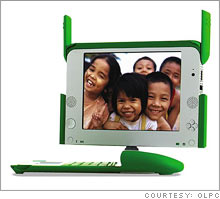Tech's biggest trend: everywhereNothing is changing IT like the adoption of technology across the developing world. Expect more than two billion PCs worldwide by 2015.NEW YORK (Fortune) -- It can't be said too often, because so few people even still understand its gravity: The adoption of technology in the developing world is tech's biggest trend. A new report by Forrester Research predicts there will be 2.25 billion PCs in the world by 2015, up from 755 million today. The vast majority of that growth will come in places like China, India, Brazil and Eastern Europe. This growth has implications for everyone developing technology, whether chips, devices, software, or Internet and communications services. If you want to go where the growth is, you have to think about the developing world. But in many cases this will mean a complete reset of business models, towards lower costs, higher volumes and ever-easier user interfaces. Writes study author Simon Yates: "Reaching these users in a cost-effective manner with technology that is relevant to their lives requires a fundamental shift in the way computer hardware and software is designed, assembled, financed, and distributed."
While that will prove hard for many companies, those who resist will risk marginalization, simply because the products that achieve volumes in the billions are likely to dominate the entire world's market. At larger volumes products can be both better and cheaper, as they benefit from ever-increasing economies of scale. Says Al Hammond of the World Resources Institute, one of the top experts on the developing world and technology: "In 10 years, technology will be completely transformed by the developing markets." Hammond says that every time he visits a cyber-caf� in the developing world there are lines of people waiting. In one small Vietnam city he visits regularly, he says there are more than 50 cyber-cafes. The Forrester study points to several big initiatives of major tech companies that will contribute to the coming surge in PC sales, some of which I've covered recently in this column. The so-called $100 laptop project of the One Laptop Per Child group (OLPC), expected to cost about $175 when it starts shipping in volume this fall, is most prominent. But Intel (Charts, Fortune 500), which OLPC's Nicholas Negroponte insists on casting in the role of bad guy, is itself pushing forward with a raft of initiatives to lower the cost of computers, make them smaller, and make them more suitable for students in developing countries. Even in the weeks since I last wrote about Intel's efforts, it has started talking about yet another major project much like OLPC's called the Eee, expected to cost about $200. Meanwhile, Intel rival (and OLPC supplier) AMD (Charts, Fortune 500) has its own project (called 50x15) to get 50 percent of the world's population onto the Internet by 2015. As these efforts, especially Intel's, suggest, though we may exceed two billion PCs by 2015, what a PC will be then will in many cases look more like today's cell phones and PDAs, even though they will do all that today's PCs can do and more. Microsoft (Charts, Fortune 500) has taken a historic step toward making affordable software available for all these machines, especially for the hundreds of millions that will be bought for students. Its Student Innovation Suite, announced in Beijing in April, includes versions of Windows and Office plus special software for math and e-mail, will cost governments only $3 when they buy it for students. Forrester says that system makers like Hewlett-Packard (Charts, Fortune 500), Dell (Charts, Fortune 500), Acer, Lenovo and Toshiba must step up more than they have so far to both hasten and take advantage of this opportunity. Writes Forrester's Yates: "There is nothing more important to the long-term health of the ecosystem of personal computing hardware and software vendors than a successful strategy for emerging markets." It's where the growth is, it's where the competition will come from, and it's where companies will define their image as the industry evolves. Already the impact of accelerating growth in the developing world is being felt in unexpected parts of technology. For instance, Friendster, the pioneering social network, now claims more than 40 million members, but the majority of them are in just a few countries in Southeast Asia. In Hammond's opinion, the killer app - at least macroeconomically - for the next phase of developing world computing may be online education, and not just for kids. It could come from people learning English using their cell phone or portable Internet device while standing in line at a bus stop, for instance. "Imagine if a real global knowledge market were to develop," he says. "That would be profound." Some of Forrester's predictions for the coming surge in computing are stunning. China, for instance, will leap from about 55 million PCs today to 500 million by 2015. India will add 156 million new PCs. The Middle East and Africa will add 110 million. Iran, with 8 million PCs today, should reach a total of 40 million. Latin America will add 171 million, Eastern Europe 85 million. Of course the real numbers are impossible to predict and Forrester uses its own complex models to come up with those estimates. The study points out that the last time Forrester surveyed global PC growth, in 2004, the debate in the industry was over whether we would reach one billion PCs by 2010. With that target to be surpassed in 2008, these new numbers seem clearly in the ballpark. The message is clear and unmistakable: Start paying attention now to what's happening with tech in the developing world. |
| |||||||


